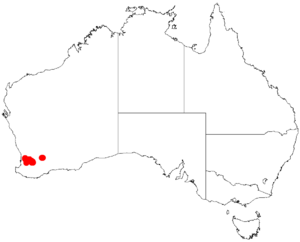Acacia gemina facts for kids
Acacia gemina is a type of shrub or small tree. It belongs to the large Acacia family, which is also known as wattles. This plant is special because it grows naturally only in a specific part of southwestern Australia. When a plant or animal is found only in one place, it is called endemic.
Quick facts for kids Acacia gemina |
|
|---|---|
| Scientific classification | |
| Genus: |
Acacia
|
| Species: |
gemina
|
 |
|
| Occurrence data from AVH | |
What Does Acacia gemina Look Like?
This plant can be a tall, open shrub or a small tree. It usually grows to be about 0.4 to 1.2 metres (1 to 4 ft) tall. It has many branches that spread out. Its small branches are covered in tiny hairs.
Like most Acacia plants, Acacia gemina does not have true leaves. Instead, it has special flattened stems called phyllodes. These phyllodes act like leaves. They are always green and stick out or point upwards. They are long and narrow, shaped like a rectangle or a spoon.
The phyllodes are tough and leathery. They are mostly smooth, meaning they don't have hairs. Each phyllode is about 10 to 25 mm (0.39 to 0.98 in) long and 3 to 6 mm (0.12 to 0.24 in) wide. You can see three clear lines, or nerves, on each side of the phyllode.
Where Does Acacia gemina Grow?
Acacia gemina is found only in the southwestern part of Western Australia. It grows in two main areas: the Peel region and the Wheatbelt region.
You can often find this shrub on rocky slopes. It also likes to grow along small valleys and creeks. It prefers gravelly soils, which are often mixed with a reddish rock called laterite. It also grows in areas where the soil is made of sandstone.
The plant's main home stretches from Brookton in the north, specifically in the Boyagin Rock Reserve. It goes south to the Saddleback Timber Reserve, near Boddington. There are also a few smaller groups of these plants. One is near Hyden and another is around Narrogin.
In these places, Acacia gemina often grows in low woodlands. Here, it can be found alongside trees like Eucalyptus drummondii. It also grows in open heathland areas, which are often filled with plants like Dryandra carduacea.

